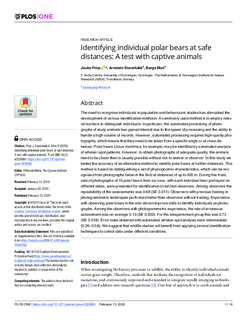Identifying individual polar bears at safe distances: A test with captive animals
Peer reviewed, Journal article
Published version

Åpne
Permanent lenke
http://hdl.handle.net/11250/2645425Utgivelsesdato
2020Metadata
Vis full innførselSamlinger
- Scientific publications [1423]
Originalversjon
10.1371/journal. pone.0228991Sammendrag
The need to recognise individuals in population and behavioural studies has stimulated the development of various identification methods. A commonly used method is to employ natural markers to distinguish individuals. In particular, the automated processing of photographs of study animals has gained interest due to the speed of processing and the ability to handle a high volume of records. However, automated processing requires high-quality photographs, which means that they need to be taken from a specific angle or at close distances. Polar bears Ursus maritimus, for example, may be identified by automated analysis of whisker spot patterns. However, to obtain photographs of adequate quality, the animals need to be closer than is usually possible without risk to animal or observer. In this study we tested the accuracy of an alternative method to identify polar bears at further distances. This method is based on distinguishing a set of physiognomic characteristics, which can be recognised from photographs taken in the field at distances of up to 400 m. During five trials, sets of photographs of 15 polar bears from six zoos, with each individual bear portrayed on different dates, were presented for identification to ten test observers. Among observers the repeatability of the assessments was 0.68 (SE 0.011). Observers with previous training in photogrammetric techniques performed better than observers without training. Experience with observing polar bears in the wild did not improve skills to identify individuals on photographs. Among the observers with photogrammetric experience, the rate of erroneous assessment was on average 0.13 (SE 0.020). For the inexperienced group this was 0.72 (SE 0.018). Error rates obtained with automated whisker spot analysis were intermediate (0.26–0.58). We suggest that wildlife studies will benefit from applying several identification techniques to collect data under different conditions.
